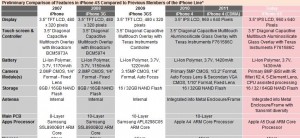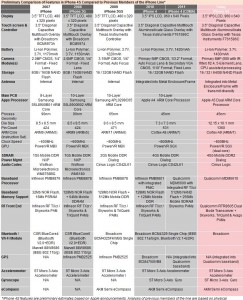 Although the size of the iPhone has stayed the same through it's four-year history, its insides have changed. Let's compare the changes.
Although the size of the iPhone has stayed the same through it's four-year history, its insides have changed. Let's compare the changes.
The main improvements on the iPhone 4S are the processor, camera and radio.
iHS offers a humongous chart of all the changes of the components of the iPhone, iPhone 3G, iPhone 3GS, iPhone 4 vs iPhone 4S. We had to cut down the chart a little to get it to fit on a page. The entire chart appears at the end of this article.
When you look on the chart there were few changes in battery size, accelerometer and no change in screen size. The new iPhone 4S has a 1430mAh battery, 10mAh more than the iPhone 4, 210mAh more than the iPhone 3GS.
The iPhone 4S uses a new apps processor compared to the single-core A4 used in the previous HSPA and CDMA iPhone 4 models. The iPhone 4S has the same dual-core A5 apps processor used in the iPad 2, likely along with the same SDRAM memory configuration at 4 Gigabits (Gb). The use of this low density of memory highlights the efficiency of Apple’s iOS operating system and lowers the cost of this memory subsystem.
The iPhone 4S integrates a five-lens camera module. The 4S camera module is an autofocus device with an 8-megapixel (MP) resolution, compared to 5MP in the iPhone 4 models. Like the iPhone 4, the 4S employs backside illumination (BSI) technology.
iPhone 4S merges the HSPA and CDMA radio capabilities found separately in the two previous iPhone 4 models into a single product that can address global wireless networks, making it a world phone. The iPhone 4S can be used on both the AT&T, Verizon and Sprint wireless networks, in contrast to requiring two different models of the iPhone 4 to work in these areas.
Click on the chart to see the whole chart.
